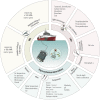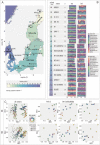A comprehensive dataset on spatiotemporal variation of microbial plankton communities in the Baltic Sea
- PMID: 38168085
- PMCID: PMC10761891
- DOI: 10.1038/s41597-023-02825-5
A comprehensive dataset on spatiotemporal variation of microbial plankton communities in the Baltic Sea
Abstract
The Baltic Sea is one of the largest brackish water environments on earth and is characterised by pronounced physicochemical gradients and seasonal dynamics. Although the Baltic Sea has a long history of microscopy-based plankton monitoring, DNA-based metabarcoding has so far mainly been limited to individual transect cruises or time-series of single stations. Here we report a dataset covering spatiotemporal variation in prokaryotic and eukaryotic microbial communities and physicochemical parameters. Within 13-months between January 2019 and February 2020, 341 water samples were collected at 22 stations during monthly cruises along the salinity gradient. Both salinity and seasonality are strongly reflected in the data. Since the dataset was generated with both metabarcoding and microscopy-based methods, it provides unique opportunities for both technical and ecological analyses, and is a valuable biodiversity reference for future studies, in the prospect of climate change.
© 2024. The Author(s).
Conflict of interest statement
The authors declare no competing interests.
Figures



References
-
- Reissmann JH, et al. Vertical mixing in the Baltic Sea and consequences for eutrophication – A review. Progress in Oceanography. 2009;82:47–80. doi: 10.1016/j.pocean.2007.10.004. - DOI
-
- Gustafsson B. Interaction between Baltic Sea and North Sea. Deutsche Hydrographische Zeitschrift. 1997;49:165–183. doi: 10.1007/BF02764031. - DOI
-
- Kuliński K, et al. Biogeochemical functioning of the Baltic Sea. Earth Syst Dyn. 2022;13:633–685. doi: 10.5194/esd-13-633-2022. - DOI
-
- Murray, C. J., et al Past, Present and Future Eutrophication Status of the Baltic Sea. Frontiers in Marine Science. 6. 10.3389/fmars.2019.00002 (2019).
-
- Viitasalo M, Bonsdorff E. Global climate change and the Baltic Sea ecosystem: direct and indirect effects on species, communities and ecosystem functioning. Earth System Dynamics. 2022;13:711–747. doi: 10.5194/esd-13-711-2022. - DOI
Publication types
MeSH terms
Grants and funding
- 34442/Villum Fonden (Villum Foundation)
- NV-03728-17/Naturvårdsverket (Swedish Environmental Protection Agency)
- NV-03728-17/Naturvårdsverket (Swedish Environmental Protection Agency)
- NV-03728-17/Naturvårdsverket (Swedish Environmental Protection Agency)
- NV-03728-17/Naturvårdsverket (Swedish Environmental Protection Agency)
LinkOut - more resources
Full Text Sources

